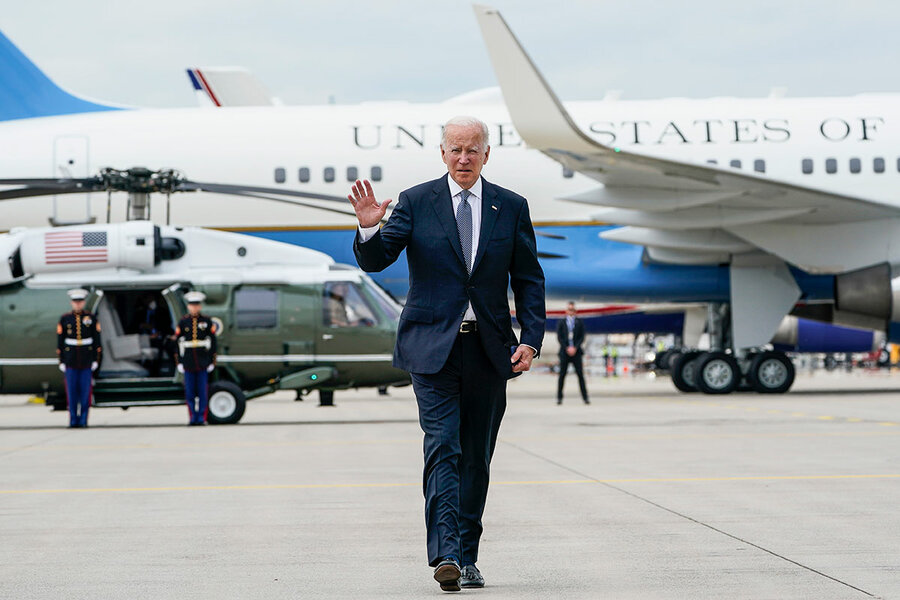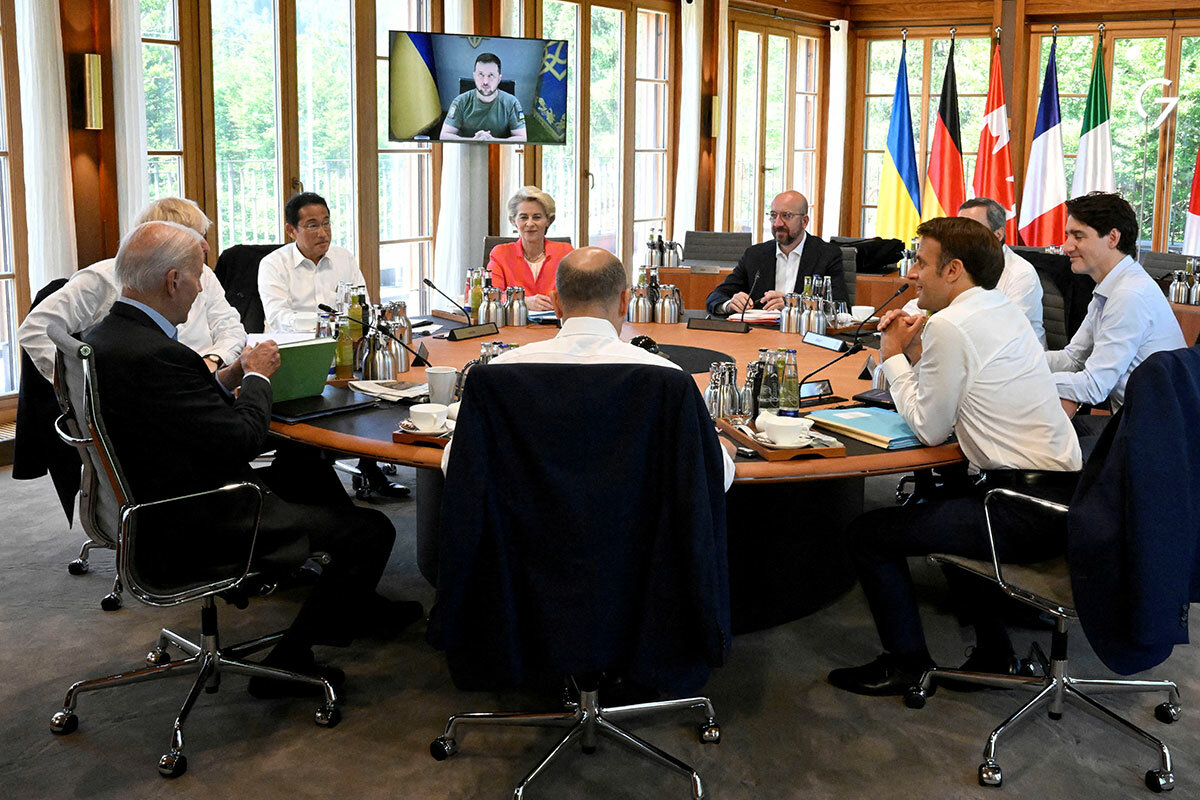Beset at home, can Biden in Europe renew faith in US leadership?
Loading...
| WASHINGTON
American leadership in a Europe confronting Russia’s aggression in Ukraine has been a rare triumph in Joe Biden’s presidency.
His stand for the rules-based U.S.-led international order that has reigned since World War II – and for the democratic values underpinning the transatlantic alliance for seven decades – steeled the spine of European allies and reinvigorated the NATO defense alliance.
Now with President Biden in Europe this week – first for a G-7 summit in Germany that ended today, and then a NATO summit in Madrid beginning Wednesday – the question for some is whether the global stage again affords him the opportunity to burnish his leadership skills.
Why We Wrote This
President Joe Biden has a hard act to follow in Europe: his own. After he positioned the U.S. as a leader against autocracy and Russian aggression, can competing with China over infrastructure freshen his moral leadership?
For many, the context is more complicated now compared with the naked challenge Mr. Biden originally faced: the stark unacceptability of Russia’s violation of established international borders and the return of big-power aggression to European soil.
Now Russia’s war of attrition in Ukraine threatens to drag on for years, not months, some experts warn, pulling down Western economies and testing public support for Ukraine’s defense. At the same time, the prospect of China teaming up with Vladimir Putin’s Russia to form an authoritarian front to undercut an alliance of democratic powers makes Mr. Biden’s principled leadership path all the more arduous, some say, even as it expands potential areas of cooperation among the Western allies.
One avenue pursued by the U.S. president diverges from the wartime leadership against Russian aggression and instead involves leading a more robust values-based competition with China in infrastructure development for poorer countries.
“Biden’s task is more difficult now than when the Russians first shocked Europe by invading Ukraine and looking like they were on the verge of taking the whole country,” says Lawrence Korb, a former Pentagon official who now specializes in national security and international policy at the Center for American Progress in Washington.
Then, for a time, Ukraine looked like it just might defeat Russia – with Western help.
“Now the Ukrainians are no longer making gains but are losing a little here and there, and instead of a one-and-done the war looks like it will be a factor in Europe for a while, hitting not just Russia’s economy but everywhere,” he says.
Abortion, guns, and U.S. leadership
Moreover, Mr. Biden’s political troubles at home and recent Supreme Court decisions on abortion rights and guns are clouding America’s image and raising questions for many international partners over how much faith they can put into U.S. leadership, Mr. Korb says.
“Countries in Europe especially are looking at the problems Biden is having at home and they wonder if it’s going to be Trump all over again in 2024, so they’re questioning America’s consistency,” he says. “Then you have the Roe decision [the Supreme Court reversing an established constitutional right to an abortion] and suddenly the image of America as a democratic leader and a beacon for individual rights has taken a big hit.”
Sven Biscop, director of the Europe in the World Program at Egmont – The Royal Institute for International Relations in Brussels, emphasizes the growing concerns over the longevity of the U.S. leadership on Ukraine.
“The first thing to be said is that there is a lot of recognition and gratitude around Europe for the leadership role the U.S. is playing in this crisis,” he says. “But while that remains very much the case, it’s also true that people are already worried about 2024. ... Everybody has this nagging little voice that we could soon be back to Trump, or some Trumpist Republican.”
Even the prospect of Republican control of Congress after this fall’s midterm elections has some in Europe on edge, experts say, given that dozens of Republican members of Congress have demonstrated much less enthusiasm for (or even opposition to) supporting Ukraine militarily against Russia.
Still, his week in Europe presents Mr. Biden with opportunities to demonstrate America’s global leadership, diplomatic analysts say, ranging from initiatives to address mounting global food insecurity to a Western powers’ international infrastructure program meant to compete with China’s Belt and Road initiative.
A values-based alternative
G-7 leaders announced the Partnership for Global Infrastructure and Investment, which aims to generate $600 billion in infrastructure development in low- and medium-income countries by 2027 – $200 billion of which the United States is pledging to mobilize through public-private initiatives.
The program is being touted as an alternative to the Chinese model, which critics say encourages overwhelming indebtedness in some of the world’s poorest countries, lacks transparency, and places Chinese interests above those of the partner country.
The U.S.-led infrastructure plan will be guided by values Mr. Biden seeks to promote internationally, White House officials say, such as labor rights and gender equity. The program will focus on four “pillars” of development, they add: climate resilient infrastructure and global energy security; secure information and communications technology; strengthened public health systems; and projects advancing women’s participation in local economies.
As one senior Biden administration said in previewing the infrastructure plan with journalists last week, the initiative is one key part of a “vision of the world” on display in Germany and Spain that is “grounded in freedom and openness, not coercion, not aggression, not spheres of influence,” and based on “cooperation” and addressing “the challenges posed by China.”
Yet while some international experts say they welcome a Western alternative to the Belt and Road initiative, they also caution that too heavy an emphasis on the new program’s restrictions could send some struggling democracies deeper into China’s arms.
“You cannot overload some of these potential partner countries with political conditionalities in order to participate in the program – going too far with standards of democracy and human rights, for example – because many of the governments will simply say, ‘OK, in that case we’ll stick with the Chinese,’” Dr. Biscop says. “Better to present these projects as an opportunity to work together on improving standards,” he adds.
NATO summit’s firsts
At the NATO summit, U.S. officials are also touting two “firsts” linking the transatlantic Alliance with Asia.
For the first time, NATO’s updated Strategic Concept to be adopted at the summit will refer specifically to China and the challenges it poses to the Alliance. Russia will continue to be recognized as “the most serious and immediate threat” to NATO, the senior administration official said, even as the new strategic concept “will also address the multifaceted and longer-term challenges posed by the PRC [China] to the Euro-Atlantic Security.”
And second, the leaders of Australia, Japan, New Zealand, and South Korea have for the first time been invited to participate in a NATO summit – an initiative White House officials say is intended at least in part as a message to both Moscow and Beijing about the strength of U.S.-led alliances.
Yet Mr. Biden may not find the same enthusiasm in Europe for expanding NATO’s horizons to Asia and taking on China’s vision of global leadership.
For one thing, Europe’s approach to China remains less confrontational than that of the U.S., some analysts note, and favors cooperative steps aimed at heading off a full-fledged China-Russia alliance.
Still others say the era of a hot war on European soil and gathering threats to NATO’s easternmost members is no time to be diverting the Alliance’s laser focus on Russia.
“If the U.S. wants to add China and the Indo-Pacific to the NATO agenda, the Europeans will go along, but that doesn’t mean there will be enthusiasm for it,” says Dr. Biscop.
In the past, debates on NATO’s purpose in a post-Cold War world always concluded that “the answer was to broaden the agenda,” he says – as when President George W. Bush pushed for a “Global NATO” during his second term.
“But the war in Ukraine has reminded us what NATO’s core task is, and that is defense,” he says. “And what we’ve learned again is that NATO is good when it is good at that core task.”







